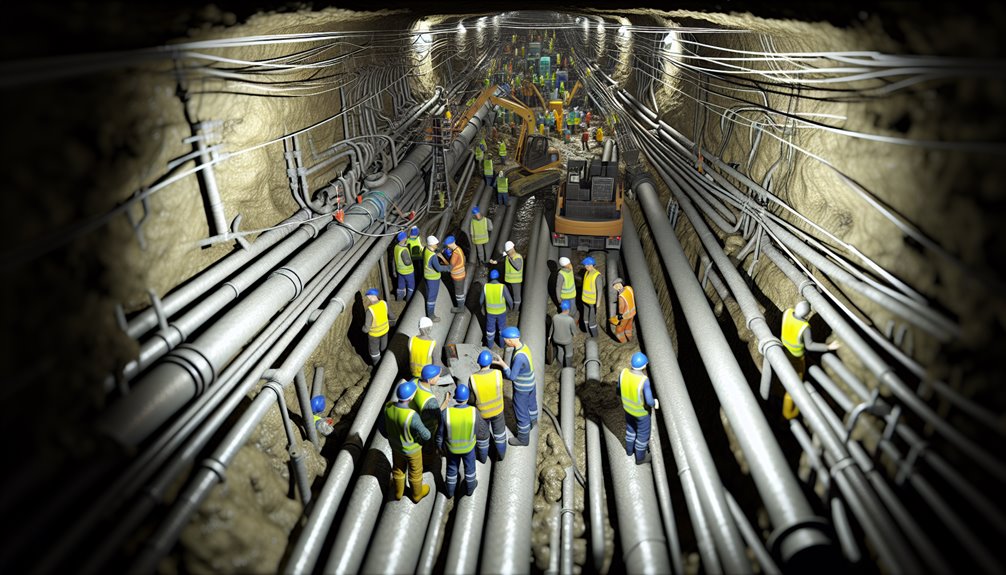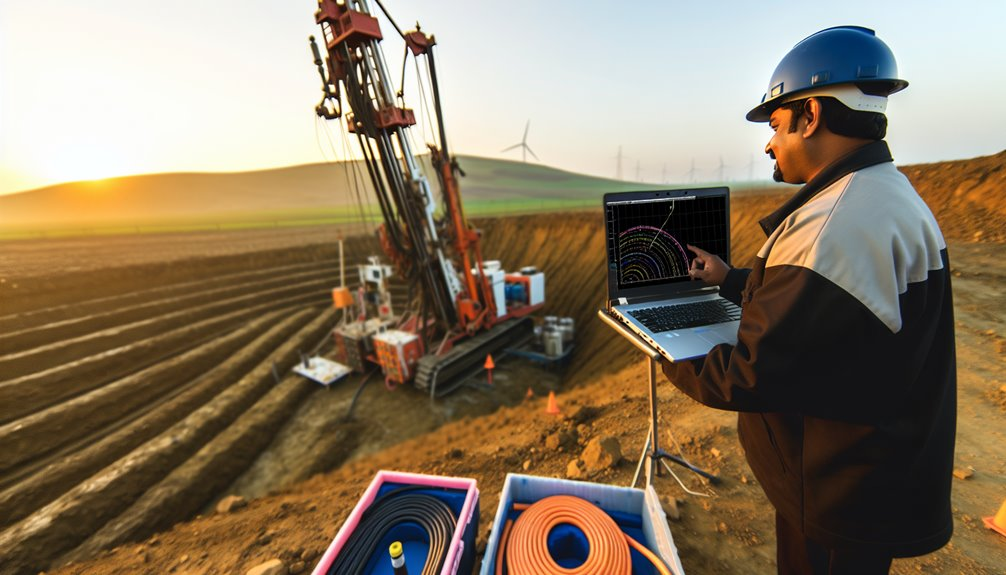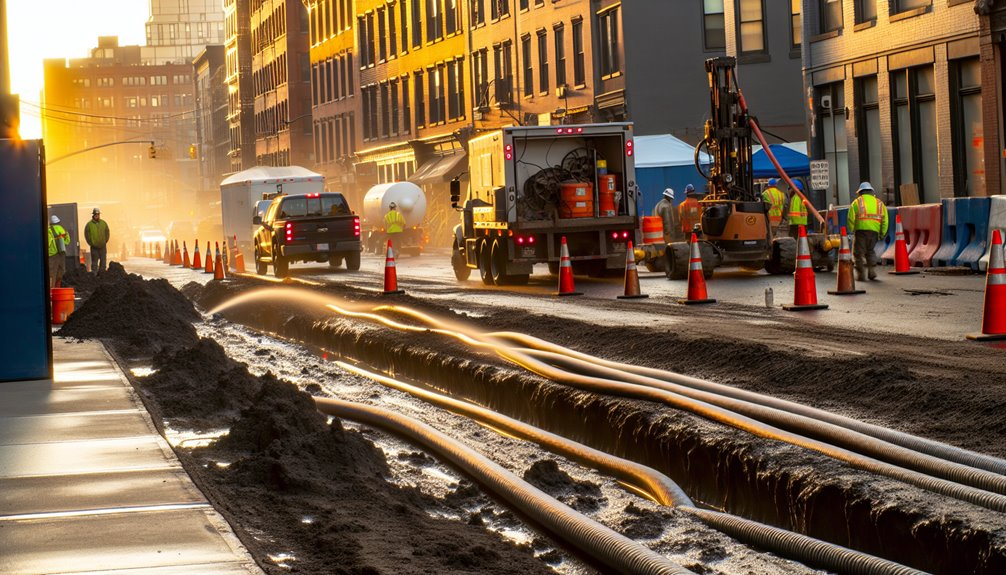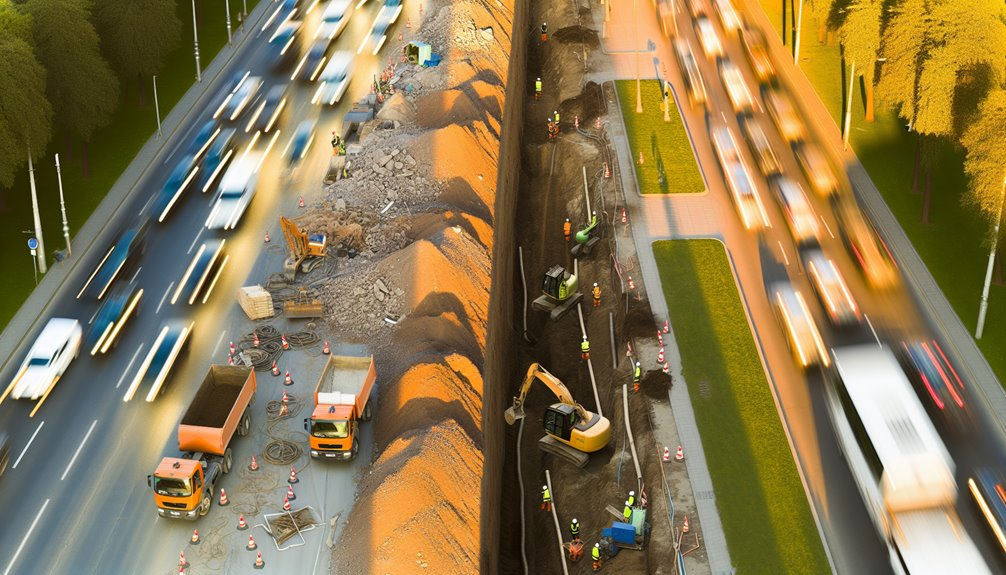When tackling underground utility construction, you'll first need to focus on precisely locating existing utilities. This isn't just about avoiding service disruptions; it's also essential for preventing potentially hazardous strikes. By integrating advanced detection technologies like GPR and EML, you can create accurate maps that guide your excavation strategy. However, this is just the tip of the iceberg. Each subsequent step, from soil analysis to stakeholder engagement, presents its own set of complexities that demand a strategic approach. Let's explore how you can navigate these challenges effectively.
Identifying and Mapping Existing Underground Utilities
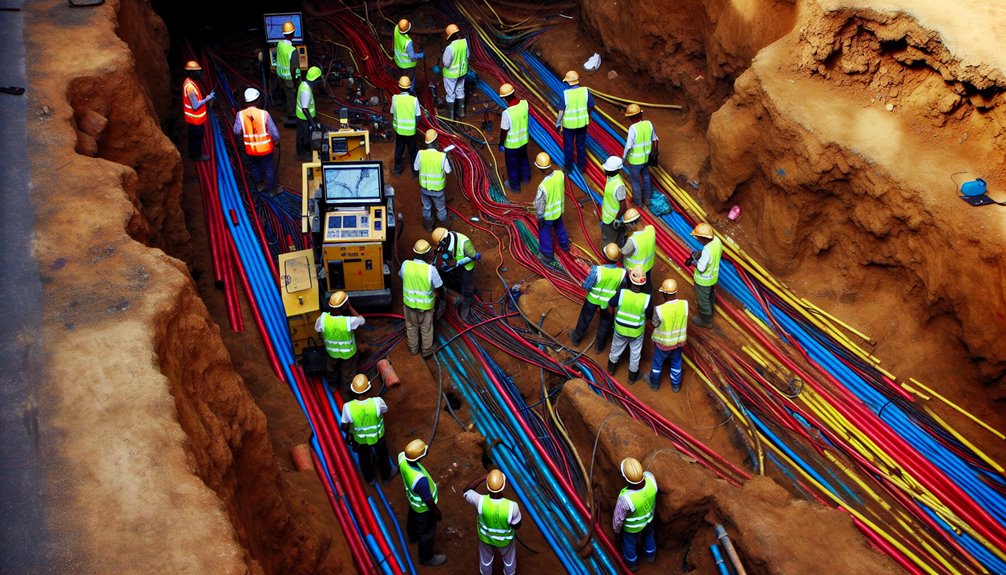
Identifying and accurately mapping existing underground utilities is essential to mitigating risks in construction projects. You must leverage advanced utility detection techniques and mapping technologies to avoid costly mistakes.
Employing Electromagnetic Locators (EML) allows you to trace metallic pipes and cables efficiently. However, for non-metallic utilities like fiber optics or plastic pipes, Ground Penetrating Radar (GPR) becomes indispensable, despite its limitations in certain soil types.
Combining these methods with Real-Time Kinematic (RTK) positioning enhances the accuracy of your utility maps to centimeter-level precision. Additionally, integrating 3D mapping technologies provides a thorough underground network view, vital for traversing complex urban environments.
To ensure comprehensive project planning, Underground Utility Mapping identifies and labels public utility mains located underground, a crucial step before any excavation begins.
Always consider these innovative approaches to optimize safety and efficiency in your construction planning.
Managing Soil and Geological Variabilities
You'll need to conduct thorough soil composition analysis and employ advanced geological survey techniques to effectively manage the inherent variabilities in soil and geological conditions. Addressing soil instability is essential; it requires precise assessment and strategic planning to mitigate risks associated with soil movement and water infiltration. Implementing these strategies can greatly enhance the stability and longevity of your underground utility projects. Additionally, understanding the general arrangement of substations and major equipment placement can inform more precise geotechnical drilling programs major equipment locations, ensuring that the design and construction phases account for soil characteristics adequately.
Soil Composition Analysis
When managing soil and geological variabilities, understanding soil composition becomes a fundamental step in underground utility construction. You must conduct thorough soil testing to identify the type of soil, such as clay or sand, and its specific properties like bearing capacity and compactability.
These tests determine how the soil will support structural loads and underground utilities. Assessing moisture content is also vital; it influences the soil's moisture retention capabilities and impacts decisions on foundation design and erosion risk management.
Accurate testing for specific gravity further aids in understanding water absorption characteristics, essential for effective drainage planning and maintaining structural integrity.
Geological Survey Techniques
Building on the understanding of soil composition, it's important to focus on geological survey techniques that manage soil and geological variabilities effectively.
To guarantee precision in your underground projects, consider these advanced methods:
- Geotechnical Assessments: Conduct thorough investigations using methods like ground-penetrating radar (GPR) and electromagnetic locators (EML) to evaluate subsurface conditions and identify potential hazards.
- GIS Underground Mapping: Utilize sophisticated GIS software to integrate data from various sources, including utility companies and previous construction blueprints, to produce accurate utility maps.
- Data Integration and Validation: Collect and cross-check data from different survey methods to maintain high accuracy levels in your geological maps, ensuring that the information is reliable and up-to-date for real-time construction decisions.
These techniques are essential in maneuvering the complexities of underground utility construction.
Addressing Soil Instability
As you explore underground utility construction, understanding and addressing soil instability is essential for the safety and efficiency of your projects.
Implementing soil stabilization techniques and erosion control methods are critical in managing the variabilities of sandy, silt, and clay soils.
Sandy soils, while easy to dig, demand robust shoring to prevent cave-ins and require specific measures to mitigate erosion.
Silt, with better moisture retention, still needs careful handling to maintain its stability and prevent shifting.
Clay poses a unique challenge; its expansion and contraction cycles necessitate advanced stabilization solutions to sustain structural integrity.
Employing these strategies not only enhances safety but also guarantees the longevity and reliability of your underground utilities.
Navigating Regulatory and Permitting Complexities
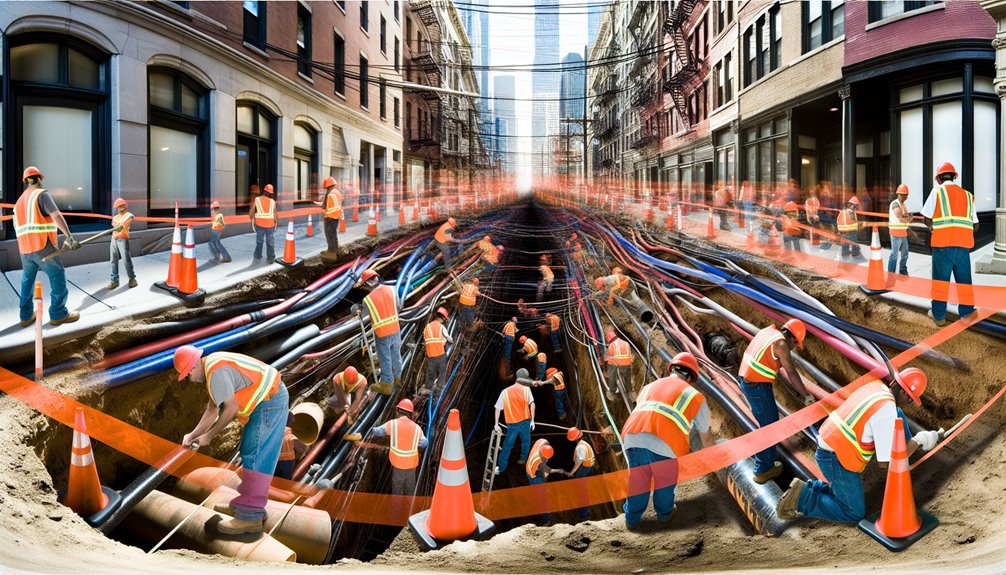
As you navigate the complexities of underground utility construction, understanding local regulations becomes pivotal.
Streamlining permit acquisition can greatly reduce project delays and cut costs, requiring a strategic approach to managing the intricate permit processes.
Adhering to compliance best practices not only mitigates legal risks but also guarantees project continuity and safety.
Understanding Local Regulations
Traversing the complex landscape of local regulations is essential when commencing underground utility construction projects.
You'll encounter various regulatory bodies, each with specific mandates and protocols. Staying abreast of regulatory updates and devising robust compliance strategies are pivotal.
- Regulatory Bodies: Engage with local agencies like Chicago's OUC or Tri-State Area's Dig Safely New York to understand distinct requirements.
- Mandatory Protocols: Adhere to the mandatory notification and marking regulations, ensuring safety and avoiding legal pitfalls.
- Permit Requirements: Differentiate between environmental and non-environmental permits, tailoring your approach to meet specific regulatory demands.
Understanding and complying with these regulations not only accelerates project approval but also bolsters safety and operational efficiency.
Streamlining Permit Acquisition
Maneuvering the complexities of permit acquisition demands a strategic approach, as multiple permits from federal, state, and local jurisdictions are often required.
You'll need to optimize your permit timeline by engaging strategically with stakeholders. Start with pre-application meetings to clarify requirements and streamline reviews. These gatherings not only expedite the process but also enhance stakeholder engagement strategies by aligning interests and resolving potential conflicts early.
Utilize technology such as GIS and online tracking systems to maintain a clear overview of permit statuses and critical timelines.
Remember, proactive coordination with all involved parties, from utility owners to local officials, is essential.
Compliance Best Practices
Maneuvering the complex landscape of regulatory compliance and permitting in underground utility construction requires a meticulous approach.
You need to guarantee utility documentation aligns with the latest standards, such as ASCE 38-22 and ASCE 75-22, which dictate precise data collection and documentation practices.
Here are key strategies to enhance compliance and streamline your project:
- Adhere to Regulatory Standards: Minimize liability and avoid penalties by strictly following established guidelines.
- Enhance Communication: Maintain clear, continuous dialogue among stakeholders to guarantee all regulatory requirements are met thoroughly.
- Leverage Advanced Mapping: Utilize technologies like 3D mapping to accurately locate and verify utilities, reducing the risk of project delays and guaranteeing safety.
Addressing Environmental Impact Concerns
As underground utility construction progresses, addressing environmental impact concerns becomes paramount to guarantee the protection of natural resources and compliance with stringent regulations.
You must focus on contamination prevention and water protection to mitigate risks effectively. Utilizing accurate utility locating techniques is critical to avoid rupturing hazardous lines, thereby preventing soil and water contamination.
Furthermore, implementing field studies and geotechnical investigations prior to excavation helps identify potential contamination sources, safeguarding against unforeseen environmental damage.
It's crucial to have robust emergency response plans and adhere strictly to regulatory requirements, like the Clean Water Act, which mandates permits and approvals to protect water sources.
Engage in proactive measures such as Storm Water Pollution Prevention Plans to promote a sustainable construction approach and maintain ecological balance.
Ensuring Worker Safety in Hazardous Conditions
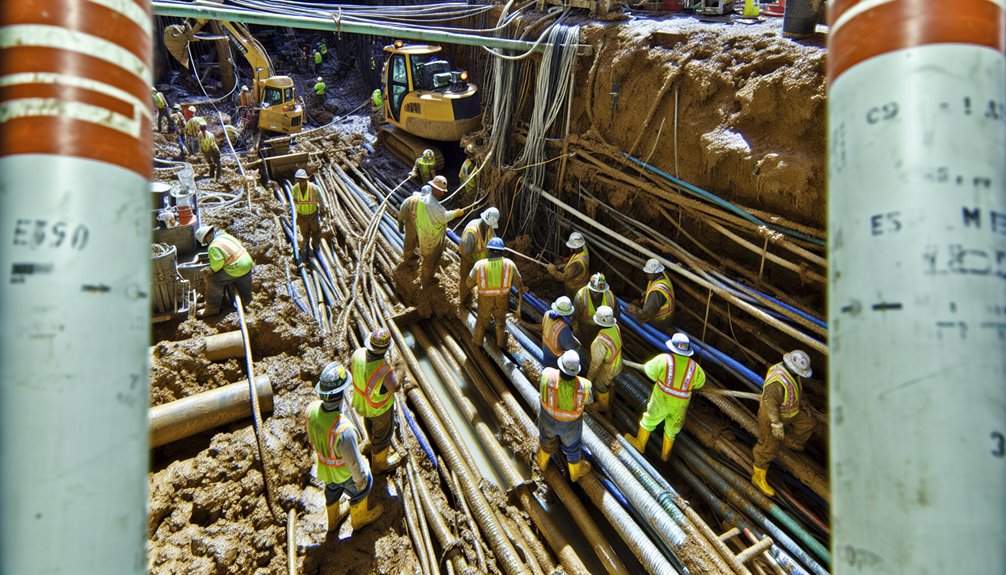
While underground utility construction is essential for modern infrastructure, it inherently poses various hazards that demand stringent safety measures to protect workers.
You must prioritize worker training and the use of advanced safety equipment to mitigate these risks effectively. Here are vital strategies:
- Comprehensive Worker Training: Guarantee all personnel are trained to recognize and avoid underground hazards such as electricity cables and encased cables.
- Use of Appropriate Safety Equipment: Equip your team with personal protective equipment and voltage detectors to prevent accidents.
- Regular Safety Audits: Conduct frequent inspections and audits of the worksite to enforce safety standards and identify potential risks swiftly.
Mitigating Damage to Existing Infrastructure
To effectively mitigate damage to existing underground infrastructure, it's essential to initiate pre-excavation planning.
Employ ground penetrating radar and other advanced technologies to guarantee accurate utility mapping, overcoming challenges like varying soil conditions and urban density.
Consistently update maps to reflect new installations and changes, integrating predictive technologies to enhance your underground awareness.
Utilize "Call Before You Dig" initiatives and one call centers for coordinated communication. This collaborative approach not only streamlines the process but also fosters a shared responsibility for damage prevention strategies.
Regularly train your team in utility repair techniques and the latest soft excavation technologies to minimize the risk of disrupting existing services.
Your proactive maintenance and inspections further solidify this commitment, preventing costly repairs and service interruptions.
Handling Unexpected Construction Challenges
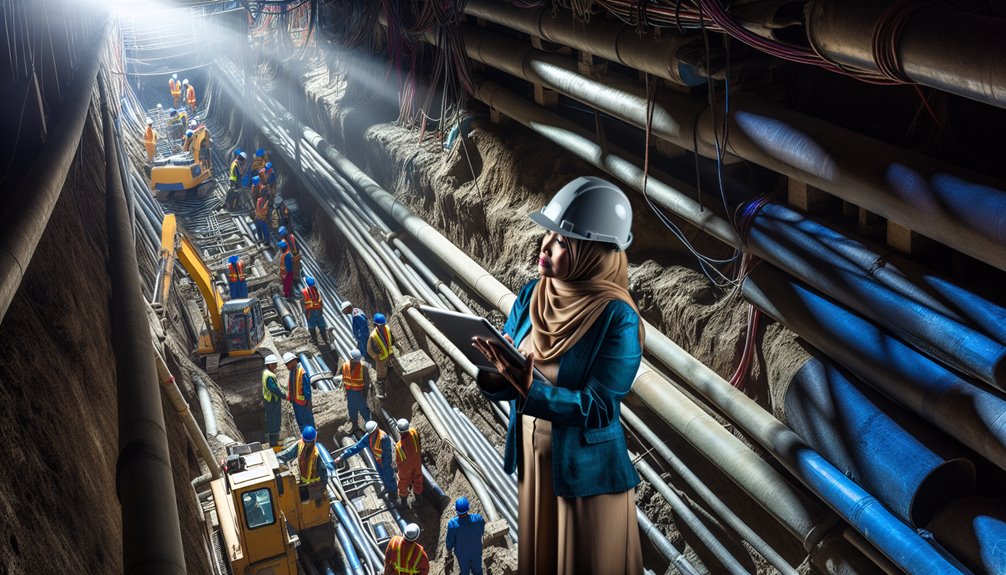
Despite best efforts in planning and pre-excavation assessments, you'll often encounter unexpected challenges during underground utility construction.
To navigate these issues, it's essential to leverage advanced utility detection methods and robust project contingency planning.
- Implement Ground-Penetrating Radar (GPR): This technology enhances the accuracy of detecting utilities at varied depths and amidst dense urban networks.
- Update and Verify Utility Records: Regularly cross-checking current construction plans with updated utility records prevents surprises related to inaccurate or outdated maps.
- Strengthen Contingency Plans: Allocate resources and time for potential setbacks, ensuring flexibility in handling unforeseen underground obstacles or abandoned utilities.
Maintaining Accurate Project Scheduling and Budgeting
You'll face challenges in predicting cost overruns due to the unpredictable nature of underground utility conditions.
Enhancing schedule adherence requires robust resource allocation strategies, tailored to accommodate the complexities of utility relocations and regulatory approvals.
It's crucial to adapt your methods dynamically, leveraging technology and precise data management to navigate these intricacies effectively.
Predicting Cost Overruns
Understanding the myriad factors contributing to cost overruns is essential for maintaining accurate project scheduling and budgeting in underground utility construction.
You'll find that thorough cost estimation and effective stakeholder communication are pivotal.
Here's how you can address these challenges:
- Implement Advanced Mapping Tools: Utilize technologies like ground-penetrating radar to enhance the accuracy of underground utility detection, thereby reducing unforeseen costs linked to subsurface damage.
- Regularly Update Cost Projections: Fluctuations in material prices and labor costs demand frequent review and adjustment of budget forecasts.
- Foster Transparent Stakeholder Communication: Guarantee all parties, including city officials and contractors, are consistently aligned on project goals and updates, minimizing costly miscommunications and delays.
These strategies aim to preempt and mitigate budgetary discrepancies, steering your projects towards financial predictability and success.
Enhancing Schedule Adherence
To enhance schedule adherence in underground utility construction, it's vital to initiate utility coordination early in the design phase. This proactive planning technique allows you to identify and mitigate potential utility conflicts before they escalate into costly delays.
Using advanced tools like ground-penetrating radar (GPR) and subsurface utility exploration (SUE) aids in the precise location of underground utilities, fundamental for avoiding unforeseen conflicts.
Implementing schedule optimization strategies, such as enforcing franchise agreements with clear timelines and penalties for delays, is critical. You must also demand accountability from utility companies for adhering to provided schedules, ensuring that any deviations are promptly addressed to maintain the project timeline and budget.
Resource Allocation Strategies
After enhancing schedule adherence through early utility coordination and advanced planning tools, it's equally important to focus on optimizing resource allocation to maintain accurate project scheduling and budgeting.
Effective resource forecasting and logistics management are vital in maneuvering the complexities of underground utility construction.
- Implement resource forecasting tools to predict and allocate labor, equipment, and materials efficiently, reducing the risk of project delays.
- Optimize logistics management by ensuring timely availability and delivery of resources, coupled with strategic storage solutions to streamline operations.
- Regularly update resource allocation plans based on real-time data from project management software, allowing for adjustments that adhere to budget constraints and schedule changes.
These strategies will help you anticipate challenges and adapt swiftly, ensuring project success.
Implementing Effective Traffic and Community Impact Management
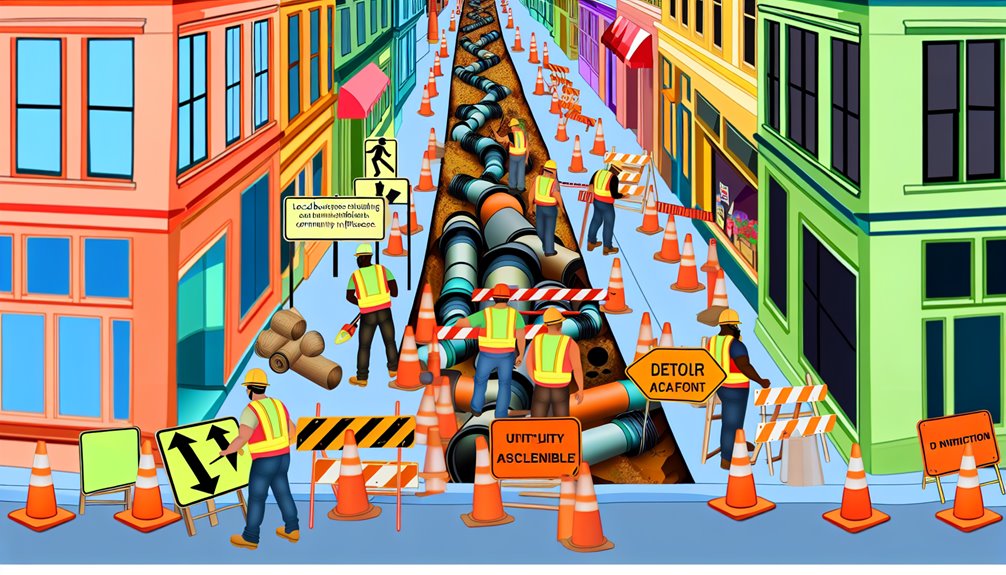
While managing the construction of underground utilities, it's vital to implement effective traffic and community impact management strategies that address both vehicular and pedestrian needs.
You'll need to develop a Transportation Management Plan (TMP) that includes evaluating project constraints and anticipating impacts to maintain smooth traffic flow and minimize community disruptions.
Implement real-time monitoring and traffic control services to adapt dynamically to changing conditions. Guarantee clear communication through signage and community engagement initiatives to keep both the public and workers informed.
Applying Maintenance of Traffic (MOT) standards is fundamental for safety and efficiency, facilitating ongoing utility operations while safeguarding pedestrian pathways and local access throughout construction phases.
Integrating Technological Advancements and Innovations
Building on the foundation of effective traffic and community impact management, integrating technological advancements and innovations further enhances the efficiency and safety of underground utility construction.
You'll find that technological integration isn't just a buzzword; it's a necessity in maneuvering the complexities of urban infrastructure.
- Ground-Penetrating Radar (GPR): Utilizing GPR in your projects means real-time alerts and depth detection, greatly reducing the risk of striking underground utilities.
- 3D Utility Mapping and Augmented Reality: These tools offer an all-encompassing view and enhanced visualization, considerably improving accuracy in utility mapping and excavation planning.
- Smart Infrastructure and IoT Devices: Implementing these can lead to efficient real-time monitoring and proactive management, ensuring sustainable and cost-effective operations.
Embrace these innovative solutions to stay ahead in the field of underground utility construction.
Conclusion
To successfully tackle underground utility construction challenges, you'll need to employ advanced detection methods like GPR and EML for precise utility mapping. Thoroughly analyze and stabilize soil conditions to prevent project delays. Engaging stakeholders early aids in smoother regulatory navigation. Prioritize worker safety with rigorous training and regular audits. By meticulously planning and incorporating technological innovations, you can enhance efficiency, manage impacts effectively, and stay within budget and schedule constraints.
If you're looking to dive deeper into the world of underground utility construction, I invite you to visit Boring Bros at boringbro.com or give us a call at (954) 639-6167. We're here to help you navigate these challenges with expertise and friendly guidance. Don't hesitate to reach out—we'd love to assist you on your next project!

